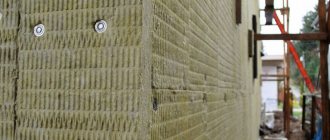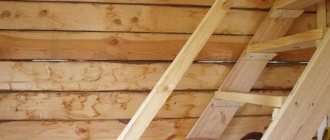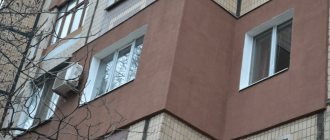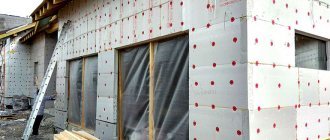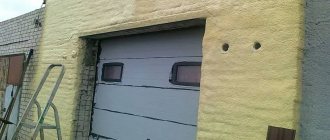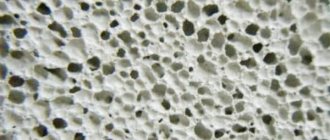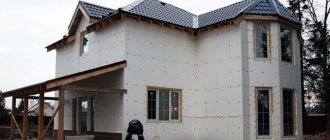Concrete is the main building material. It is found everywhere and has many positive characteristics. But its thermal conductivity coefficient is high, so the material is cold. Heat escapes through the walls, so a lot of money is spent on heating. The only option is to insulate concrete walls. There are many materials for this purpose, and the work itself can be done with your own hands.
Thermal insulation of concrete - features
The peculiarity of concrete walls is that in order to insulate them, everything needs to be calculated and planned in advance. The task is not easy when compared with walls made of brick or wood, but it is doable. Insulation of a concrete wall outside and inside has the following features:
- The surface must be treated with antiseptic agents.
- Communications and wiring are laid even before thermal insulation work.
- When insulating a façade, the entire area is treated; you cannot do only certain areas or a wall.
- Areas behind heating radiators are treated using insulation with foil. This is a thin aluminum layer on insulation. It will reflect thermal energy.
If we talk about internal insulation, there are also some nuances here. For example, condensation will accumulate inside, since the moisture has nowhere to go. Therefore, it is important to ensure good ventilation. In addition, environmentally friendly insulation is selected that will not harm health.
Basic methods
Modern manufacturers delight customers with a wide range of various thermal insulation materials that meet the basic quality parameters of these products.
However, experts with sufficient experience in the construction industry give advice on how to insulate a concrete wall in an apartment using only three main methods, which are considered the best:
- Insulation using foam plastic,
- Insulation with mineral wool,
- Insulation using a warm plaster solution.
Application of foam plastic
Today, foam plastic is considered a popular insulation material (for example, Penoflex insulation). It is lightweight, easy to use and low price make it the most common insulation material.
Insulation of premises from the inside with polystyrene foam
This method of thermal insulation is both the simplest and cheapest:
- Carefully plaster the concrete wall.
- Let the solution dry completely.
- We begin to level the surface by applying one layer of putty.
- Upon completion of puttying, we lay waterproofing material around the entire perimeter.
Note! Neglecting this stage of thermal insulation work often causes condensation at the junction of the wall and the insulation, as well as its further dampening. After all, it’s no secret that even polystyrene foam is afraid of moisture and rots from its excess, losing its beneficial properties.
- Next we move on to installing the insulating layer:
- we treat the walls with special glue,
- We lay the sheets of foam plastic end-to-end, one to the other, avoiding the formation of cavities between them.
Advice! To ensure that the insulation adheres well, do not under any circumstances try to apply glue to the foam sheets themselves.
Method of internal insulation with foam plastic
- We complete this stage of work by installing the vapor barrier material on the foam layer.
Application of mineral wool
The second method of insulating concrete walls and increasing their thermal insulation capabilities is more difficult to implement. In addition, insulation with mineral wool can only be done if there are wooden slats. Lath lathing “steals” some space in the room due to its thickness, so it is difficult to use if you want to insulate a loggia. Therefore, thermal insulation experts advise against plastering walls if this technique is used. However, no consensus has been found on this issue.
Related article: Treating bathroom walls before laying tiles
Photo of insulation with mineral wool
The following are instructions for insulating walls with mineral wool:
- we install wooden slats vertically on the walls, using a level for accuracy,
- we fill the distance between them with waterproofing material, fixing it directly to these slats.
- We proceed to laying the insulating material on top of the waterproofing material. Monitor the density of the insulation in the space between the slats. There should be no gaps between the slabs of material and the wooden slats. To do this, the distance between the slats is made less than the width of the insulation material.
Laying without gaps between slabs and slats
Note! Remember the risk of the formation of “cold bridges” and, in order to avoid this phenomenon, fix the insulation joint to joint between the slats, that is, trim the material with allowances of one centimeter.
- All that remains is to put in a vapor barrier material. Fix it on the same wooden slats.
Advice! Experts, just in case, advise laying mineral wool in 2 layers if you are not going to make a plaster layer.
Application of plaster solution
The use of a plaster layer as a thermal insulation material is not a new technology. However, even today it remains quite popular. However, one should not think that this method of thermal insulation is too simple. It also has its own characteristics, including a three-layer plaster layer.
So, how does insulation work using plaster:
- Applying the initial layer with your own hands is carried out by uniformly spraying the surface with a liquid plaster solution. This is done so that the solution penetrates as deeply as possible into the walls having microscopic cracks.
- The second layer, 50-60 mm thick, is soil. Moreover, it is applied not in one, but in 2-3 layers. This takes time and patience.
Advice! Dry each layer thoroughly to prevent it from falling off the wall under its own gravity.
- And finally, the plastering of the wall is completed with a third layer, which is called “covering”. This layer is done in order to finally level out all surface irregularities and increase its thermal insulation properties.
How to apply plaster
Where to insulate, inside or outside
The first question that arises before starting insulation. The answer to this is ambiguous, since these options have their pros and cons. For example, insulation from the inside is often done in apartments with more than 3 floors, especially in high-rise buildings, since working outside is dangerous. In addition, the heat insulator inside will not be exposed to the negative influence of the street, and the insulation process itself can be performed in any weather and season. But there are also disadvantages: reduction in living space, condensation formation, release of harmful substances.
External insulation is a more common option, as it allows you to protect a concrete wall and cover it. It is more convenient to work outside and there is no loss of living space. There is no human contact. And the insulation inside causes the wall to freeze itself. A phenomenon occurs in which the wall, on one side, is insulated from the heat of the rooms, and on the other side is constantly exposed to sub-zero temperatures. That is why it is better to insulate concrete walls from the outside. But it is still up to the owner to choose methods for insulating concrete structures.
Methods of external insulation of facades
In total, there are two ways to install insulation on the facade of a building:
- Dry method or ventilated facade.
- Wet method.
Each technology has its own advantages, so we will consider each option separately.
Insulation of facades ventilated facade
The dry method does not involve the use of mixtures with added water. In order to create a thermal insulation layer using this method, a thermal shield is made from insulation materials, which are covered with panel materials. The materials we have already discussed are used as insulation materials. The façade is called ventilated because a small air gap is left between the panel material and the insulation to ventilate the insulation.
Facade insulation wet facade
This method involves insulating the façade surface using specialized water-based mixtures. These mixtures can have different compositions. Recently, cellulose-based foam insulation has been increasingly used. The main advantage of this method: filling all cracks and holes. The wet method does not leave cold bridges through which heat can flow out of the room.
Insulation methods
A variety of insulation methods allows you to choose the best option for yourself, in accordance with your financial capabilities and preferences.
The first option is to use polystyrene foam
Polystyrene foam is a cheap and practical material. Suitable for those who have a limited budget, at the same time, it has excellent characteristics. You can buy EPS (extruded polystyrene foam). It has better characteristics, but the price is not very high. But it is not recommended to insulate concrete walls from the inside.
Algorithm for performing the work:
- Along the perimeter at the bottom there is a plinth that will serve as a stand for sheets.
- Fixation is done with glue. Can be applied in a continuous layer with a notched trowel or in spots, around the perimeter and in the center.
- The first mat is fixed from the corner, and so on for the entire row. The rest are close to them. The next row is laid offset so that the seams of adjacent rows do not intersect.
- Additionally, the mats are fixed using dowels with an umbrella. Holes are drilled using a hammer drill and dowels are driven in. For 1 sheet you need 5 dowels.
- When the glue dries (from 1 to 2 days), the reinforcing mesh is glued. To do this, glue is applied to the foam, and the mesh is embedded in it. An overlap of 5-10 cm is made at the joints.
- After drying, the walls are plastered.
At the end, all that remains is to prime the wall and do the finishing touches. This method is called a wet facade.
The second option is to use PPU
Polyurethane foam is a heat insulator applied by spraying. It is somewhat reminiscent of polyurethane foam. When the components are mixed and react with air, the material begins to increase in size, filling the entire space. The option is modern and effective. The material is not afraid of moisture. Internal and external insulation is possible. However, the process of insulating concrete walls with polyurethane foam requires special, expensive equipment.
The work is done quickly, the layer turns out monolithic, without cold bridges. However, it is vulnerable to UV rays. In addition, the layer does not allow steam to pass through; a ventilation system is needed. The essence of the work is to apply material from the compressor to the surface.
The third option is thermal insulation plaster
If you need a cheap, quick way to insulate concrete walls, then you can use heat-insulating plaster. However, it is not a full-fledged heat insulator; for cold regions this is not an option, only combination with other materials.
Preparation
Each building material differs in its reaction to environmental influences. Concrete is no exception. In terms of performance, it is superior to brickwork and wood, but requires good thermal insulation. Before you start insulating concrete walls from the inside with your own hands, you need to take into account the following nuances:
- At high density, the monolith remains a water-permeable material, which negatively affects both the condition of the insulation (if they are not able to withstand moisture) and the walls - in cold seasons, condensation will begin to freeze, triggering deformation processes.
- Before carrying out work, concrete is treated with an antiseptic agent, which will prevent the formation of fungi and mold.
- Thermal insulation should cover the entire facade, and not individual parts of the building.
- The amount of insulation is selected taking into account the thickness of the walls.
From inside or outside?
Having decided on the material for insulating a concrete wall from the outside or arranging thermal insulation in an apartment from the inside, you need to consider the features of each method. Experienced experts recommend putting the main priority on external insulation, since without it, internal insulation will be ineffective and will only aggravate the problem.
Material counting
The consumption of insulating materials depends on a lot of factors. First of all, the evenness of the surface of the wall that will be insulated is taken into account - this indicates the amount of glue for fixing the foam.
Calculations are carried out for smooth walls according to the following principles:
- To glue foam boards onto the “pads” (without an adhesive layer around the edges), you will need to use 5 kg of polystyrene foam glue.
- The dimensions of the slabs must correspond to the parameters of the walls without taking into account openings (windows and doors). The thickness of the material is determined by the region of residence.
- To strengthen the plaster, reinforcement with facade fiberglass mesh is used. The number of reinforced concrete structures is selected taking into account the parameters of the wall.
- If the facade will be covered with decorative plaster, then to level the surfaces you will need to purchase a primer with quartz sand. The consumption of this composition is 300 g/m².
- Before painting structures, they must be treated with a deep penetration primer - 200 g/m².
- The consumption of plaster is determined by the size of its grains.
- The consumption of the coloring composition depends on the application method (spray gun, roller and brush).
Related article: How to remove a socket from a wall
Surface preparation
After purchasing materials for wall insulation, you can proceed to surface preparation. To do this, you need to clean them of old paint, mold and dirt, and then cover them with an antiseptic.
In the upper part, the wall is coated with a primer, which will increase the adhesion of the material to the adhesive base.
Insulation instructions
If you do not take into account the option of using polyurethane foam, then all the work is done with your own hands. It is important to familiarize yourself with some nuances and begin the task:
- Insulation of concrete walls is carried out in dry weather, at temperatures from +5 to +30 degrees.
- The wall is well dried, not damp.
- It is important to clean the surface, remove all excess, seal cracks and level it. Mold, mildew, and greasy stains are removed.
At the end, all that remains is to treat the concrete with an antiseptic and get to work.
Using polystyrene foam
The advantages of polystyrene foam are considered, as is the technology for creating a wet facade. But, there is a second option - frame. Sequence of work:
- The sheathing is placed on the surface.
- The distance between the slats is identical to the width of the foam sheet.
- Insulation is installed in the created cells.
- Everything is covered with lathing and the structure is finished with finishing panels: block house, lining, siding.
For insulation in cold regions, the layer thickness is from 10 to 20 cm.
Using mineral wool
Mineral wool is an excellent material with excellent characteristics. However, she is afraid of moisture. Therefore, when thermally insulating concrete, it is necessary to create a ventilation gap so that the wool dries. Here we need the frame technology described above.
Features of the work: after creating the sheathing, mats or rolls of mineral wool are installed. It is important to lay them tightly, without forming joints. To do this, the distance between the slats is made 5–10 mm less than the width of the wool. All that remains is to fix the vapor barrier, glue the joints and sheathe the frame with the selected material. An apartment can be insulated with mineral wool both from the outside and from the inside.
Using thermal panels
Thermal panels are a multilayer material. It is made of insulation and decorative material. The manufacturer has simplified the task; a concrete house can be insulated with such panels, and not have to think about additional finishing. Typically used for exterior decoration. Installation is simple - just apply glue to the surface and fix it on the wall.
Using foam glass and fiberglass
Foam glass is an insulating material in the form of slabs, the density of which is from 100 to 150 kk/m3. Such insulation is fixed to the wall using glue. The structure can be strengthened with dowels, as is the case with polystyrene foam. The finishing layer is different, ordinary plaster, drywall or decorative panels.
The peculiarity of the material is that it is not afraid of moisture, is environmentally friendly, and is not damaged by rodents. Cutting mats is quite simple. The surface can be strengthened and secured with reinforcing mesh and corners. The disadvantage of such insulation for concrete is that it has a high cost.
Using penofol
This is foil insulation. It is environmentally friendly, efficient and practical. The thickness is small, which allows you to quickly fix it on the wall. The layer is vapor-proof. However, penofol is not suitable as the only insulation material. It is better to combine it with other heat insulators or use it as a heat-reflecting layer and vapor barrier material. Installation is carried out on the wall or on the lathing.
Before insulating concrete walls, it is important to think through the sequence of work in advance, choose what to insulate the structure with, comparing all the pros and cons, and then get to work. But, if you are unsure of your abilities, it is better to overpay, but entrust the work to specialists who will do it efficiently and without errors.
Do-it-yourself insulation of concrete walls from the inside
Often the walls of newly built buildings have a low level of thermal protection. This applies most of all to buildings built from concrete. They are in dire need of enhanced insulation. The desired effect can be achieved by using different materials to insulate the structure not only from the outside, but also from the inside.
Review of the most popular methods
- The most inexpensive method is considered to be additional plastering. The surface to be insulated is primed in advance, after which a reinforcing mesh is fixed to it. Several layers of plaster are applied on top of it. The approximate layer thickness is 0.5 millimeters. A waterproofing layer is laid under the layer of plaster; it can also be a simple polyethylene film.
- If you plan to use mineral wool as insulation, you will need to construct a cellular sheathing from an aluminum profile or wooden beam to accommodate it. If the second option is chosen, the wood will need to be treated with an antiseptic compound that will prevent rotting.
- Expanded polystyrene is a panel whose nominal size is usually 100*100 cm. During the installation process, they will need to be precisely adjusted to the size of the cells. To create a tight connection, the joints should be treated with a sealing agent. It is extremely important to connect the sheets tightly to the base of the wall to avoid the formation of air pockets. Condensation can accumulate in them, causing mold to form.
- Polyurethane is one of the most reliable methods of thermal insulation of concrete walls. It is able to create a barrier to moisture. Unfortunately, the material hardens quickly, so it is not so easy to apply it well. It is better to do this using a special installation. You will also need to install a vapor barrier layer.
Related article: Maximum support of floor slabs on a brick wall
Recommendations from specialists on the correct organization of the process:
- Removing the old wall covering.
- Drying and wiping the base.
- Treating the wall surface with an antiseptic.
- Applying primer.
- Fastening the selected insulation material.
- Application of decorative finishing.
It is better to insulate a concrete wall from the inside in spring or summer, during periods of low air humidity and absence of heavy rainfall. Even at the stage of preparation for the main work, you should check all communications located on the surface and, if necessary, secure or replace them. After finishing the finishing work, it will be difficult to carry out these actions.
The insulation process must be carried out throughout the apartment, and not in one specific room. The effect will be more significant, heat will be better retained in the home. It is important to provide for a ventilation gap between the insulating layer and the surface decor. This way, moisture will not accumulate in the heat insulator in case of temperature changes.
Common mistakes when insulating concrete walls
Most mistakes come down to the wrong method of insulation. Namely, insulation from the inside. This is fraught with many negative consequences. In addition, it is better to choose moisture-proof materials as insulation.
Sometimes insufficient attention is paid to the preparation of a concrete wall: cracks are not repaired, mold, stains or mildew are not eliminated. This can lead to the insulation cake peeling off and all the work will be in vain.
When creating a reinforced layer on a wet facade, it is important to place the mesh correctly. It will strengthen the structure and protect the surface from cracks. However, it cannot be glued to foam plastic and glue should be applied on top. In order for the mesh to perform its functions, it is embedded in a layer of glue. Then the mesh will be inside the adhesive mass.
Another mistake is failure to maintain temperature conditions when working outside. The insulation process is carried out in dry weather, at the specified temperatures. If it is below +5 degrees outside, it is better to wait for comfortable conditions.
If you follow all the recommendations, you can avoid mistakes and the work done will not be in vain.
Materials for insulating the walls of panel houses outside
Today's market for thermal insulation materials is huge, but there are products that are deservedly considered classics for thermal insulation of a panel house outside .
Among these materials are:
- mineral wool;
- sandwich panels;
- Styrofoam.
Figure 2. Expanded polystyrene for facade insulation.
Let's look at each of the options separately to understand what advantages this or that type of insulation has.
Mineral wool
Mineral or stone wool is usually called insulation based on extruded stone chips. The point of using stone is that it creates a foam slab with stable walls. The internal space of such a stove is 90% filled with air. And today air is the material with the lowest thermal conductivity. Therefore, all insulation materials include air.
There are three types of mineral wool:
- Basalt mineral wool with a synthetic binder. This is the most popular option. If you hear someone talking about mineral wool, then most likely they mean this type of insulation. Mats made from this material are loved by all heating engineers for their ease of installation, low cost and good thermal insulation properties. However, basalt wool is used extremely rarely for insulating façade houses, since its installation requires a frame that must be thermally insulated separately to prevent cold bridges from appearing.
- Glass wool. It was used everywhere for insulation in the last century. Now it is completely unsuitable as insulation: it constantly crumbles, falls off quickly and is extremely dangerous to install. When installing basalt mineral wool slabs , it is enough to use a respirator. To install glass wool blocks, you will have to protect your entire body. In addition, the thermal insulation characteristics of the material are very mediocre.
- Mineral wool based on cellulose. The name speaks for itself. This is a fire hazardous insulation made from foamed paper residues. The main advantage that manufacturers are trying to cling to is environmental friendliness. But the insulation does its job poorly, and therefore there is no particular point in using it.
Sandwich panels
Sandwich panels are used primarily due to the possibility of quick installation. The panel itself is insulation sandwiched between two layers of structural material. The following acts as insulation:
- Foamed polyurethane. High quality but expensive material. It is not profitable to use it to insulate the facade of an apartment panel building. But a sandwich panel with such insulation is perfect for a private home.
- Mineral wool. This insulation has already been mentioned earlier; all its properties are transferred here completely. The use of sandwich panels protects the mineral wool board from precipitation, making installation easier.
- Styrofoam. These are the most popular sandwich panels. The insulation used makes them lightweight and quite effective.
Styrofoam
Foam plastic is the most popular material in Russia for insulating building facades. The undoubted advantage of this insulation is that it is absolutely not susceptible to moisture, when the basalt mineral wool slab turns into rags over time. As a rule, the service life of such insulation does not exceed 10 years. Foam manufacturers guarantee from 30 to 50 years of service.
Figure 3. Insulating the facade with polystyrene foam.
The foam is attached to the facade using dowels or special glue. And most often, both methods are combined to create a reliable fastening.



